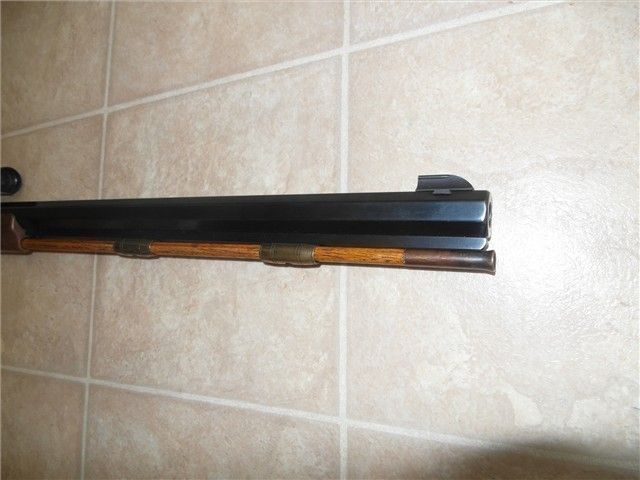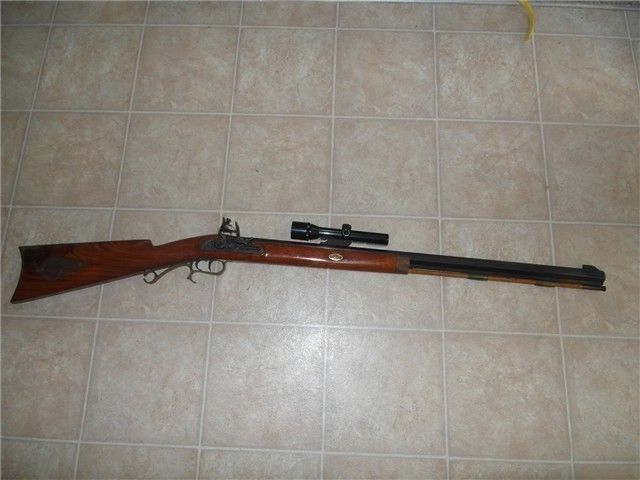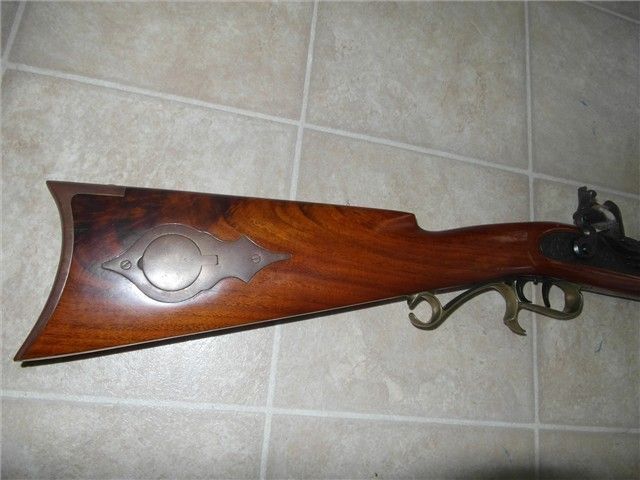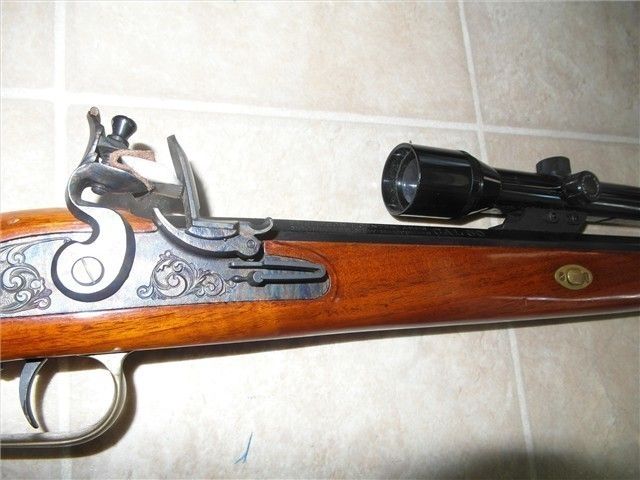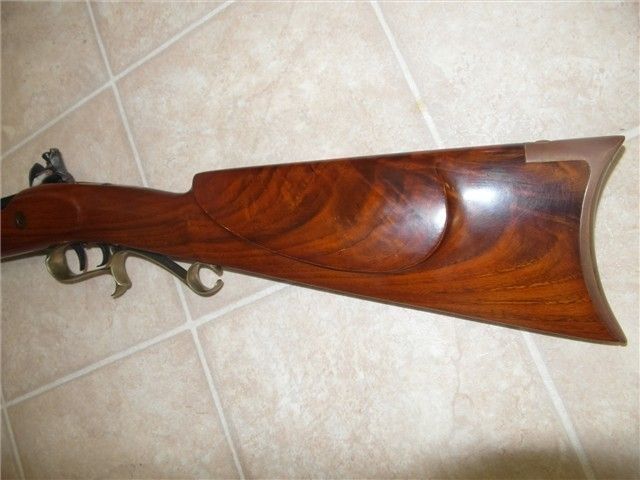-
Friends, our 2nd Amendment rights are always under attack and the NRA has been a constant for decades in helping fight that fight.
We have partnered with the NRA to offer you a discount on membership and Muzzleloading Forum gets a small percentage too of each membership, so you are supporting both the NRA and us.
Use this link to sign up please; https://membership.nra.org/recruiters/join/XR045103
You are using an out of date browser. It may not display this or other websites correctly.
You should upgrade or use an alternative browser.
You should upgrade or use an alternative browser.
Lock finish
- Thread starter sarcasmn
- Start date

Help Support Muzzleloading Forum:
This site may earn a commission from merchant affiliate
links, including eBay, Amazon, and others.
- Joined
- Aug 25, 2003
- Messages
- 6,392
- Reaction score
- 1,268
It's really your call. If it was me, I'd brown the lock and barrel. You could cold blue the lock also. Just depends on your likes.
The RPL locks essentially come as bare metal, somewhat "frosted gray", unlike the factory TC locks that have the case hardened looking finish. So you will probably want to blue or brown to match the barrel unless you are going to leave everything gray. I use LMF for browning, and Oxpho Blue for cold blue. There are lots of posts about using things like naval jelly, mustard, etc., if you want a more grayish finish.
don hepler
58 Cal.
- Joined
- Nov 19, 2010
- Messages
- 2,260
- Reaction score
- 10
TC Hawken's can take on a whole new look, if you use your imagination. One guy on here made a Renegade look sharp with an ebony tip, refinished stock was darker. But if you're just going to replace the lock, I'd use cold blue, steel wool, between coats, til you achieve the look that you like.
I am not sure what I have here. It's a TC Hawken. I suspect that it has never been fired or just a few times. The bore is shiny and looks real good. The rear sight has been removed and a scope is attached. The frizzen looks like someone fired it a couple dozen times and the barrel has none of that warning stuff, just says Thompson Center Arms Rochester New Hampshire CAL 50 on one flat and 1976 on another. No serial number. Looks very safe queen.
I am not a fan of brass furniture. I plan to change the forend cap with a nickel silver one, iron butt plate and trigger guard using the browning solution but scalding them so they turn that dark plum. L&R lock, silver escutcheons and silver ohio paisley inlays on fore end. I am not sure what to do about the patch box. I am thinking of filling in the cavity and covering it with some kind of wood inlay. The wood on this lady is beautiful. I would post pics if I knew how
Still a newbie so any ideas or suggestions are always welcome.
I am not a fan of brass furniture. I plan to change the forend cap with a nickel silver one, iron butt plate and trigger guard using the browning solution but scalding them so they turn that dark plum. L&R lock, silver escutcheons and silver ohio paisley inlays on fore end. I am not sure what to do about the patch box. I am thinking of filling in the cavity and covering it with some kind of wood inlay. The wood on this lady is beautiful. I would post pics if I knew how
Still a newbie so any ideas or suggestions are always welcome.
A lot of TC stocks, especially the older ones sure had some nice grain patterns. 
As for the new locks finish, like the others said, do whatever you want to do with it.
It takes a lot of sanding and polishing but I polished the locks on this CVA 12 guage SXS and left them "in the white".
I think they contrast nicely with the rest of the gun.

As for the new locks finish, like the others said, do whatever you want to do with it.
It takes a lot of sanding and polishing but I polished the locks on this CVA 12 guage SXS and left them "in the white".
I think they contrast nicely with the rest of the gun.

don hepler
58 Cal.
- Joined
- Nov 19, 2010
- Messages
- 2,260
- Reaction score
- 10
That is a very early TC Hawken. The frizzen and cock are case hardened. Some people claim that the newer (Black) frizzen and cock (with a different angle), are better. TC replaced mine, with the newer. I offered to pay, but they replaced it free. Birchwood Casey makes a brass black, that will make the brass antique patina. 44/40 cold bluing will do the same. I recommend, to those who "can", learn to completely disassemble a lock. You will live a happier life.
Your rifle should have a slotted touch hole, a lot of people replace them with TC's newer, allen style liner. Suppose to improve ignition. I put a little anti-seize on treads. Same threads as a nipple, and I treat it the same, and remove it during cleaning. I just snug it, the lock sets against it anyway. I remove the lock every time I clean the rifle, and check screws, spray with oil and remove all excess. That rifle, has a barrel made by Douglas, or other major barrel maker, and should have a spade or maltese cross stamped on the bottom of the barrel. Should be a good shooter, mine is. That TC scope is an antique now, and you might be able to remove it, and find the original replacement sights. The hole spacing was different on the early Hawkens. So beware if you are buying a rear sight.
Your rifle should have a slotted touch hole, a lot of people replace them with TC's newer, allen style liner. Suppose to improve ignition. I put a little anti-seize on treads. Same threads as a nipple, and I treat it the same, and remove it during cleaning. I just snug it, the lock sets against it anyway. I remove the lock every time I clean the rifle, and check screws, spray with oil and remove all excess. That rifle, has a barrel made by Douglas, or other major barrel maker, and should have a spade or maltese cross stamped on the bottom of the barrel. Should be a good shooter, mine is. That TC scope is an antique now, and you might be able to remove it, and find the original replacement sights. The hole spacing was different on the early Hawkens. So beware if you are buying a rear sight.
don hepler
58 Cal.
- Joined
- Nov 19, 2010
- Messages
- 2,260
- Reaction score
- 10
Here is my rifle.
 [/[URL=http://s948.photobucket.com/user/HaddenWest/media/rc203_zpseceaa6bc.jpg.html]
[/[URL=http://s948.photobucket.com/user/HaddenWest/media/rc203_zpseceaa6bc.jpg.html]
 URL]
URL]
 [/[URL=http://s948.photobucket.com/user/HaddenWest/media/rc203_zpseceaa6bc.jpg.html]
[/[URL=http://s948.photobucket.com/user/HaddenWest/media/rc203_zpseceaa6bc.jpg.html]
 URL]
URL]Pete G
76 Cal.
Most old locks left the gunmaker in the white. I use phosphoric acid, sold as rust remover to put sort of a dark gray and somewhat rust resistant finish on the locks of what I build. Your brass has a nice aged finish, so if I were you I would just leave it alone (and take that scope off and replace it with some "proper" sights).
You guys crack me up. I agree that there is no reason to sully a nice proper smoke pole with a scope. I promise to put simple iron sights on this rifle at the first opportunity. The pictures were from gunbroker and that's the way the gun came. I have already taken the scope off.
Please stop plotting my demise, I have removed the offensive scope.
Please stop plotting my demise, I have removed the offensive scope.
Staggerwing
40 Cal.
Zonie,
I remember a post some time back where you went through the procedure of bluing screw and bolt heads with a torch and heating them the temperature where they get that blue cast to them. Is it possible to do the same with the lock and hammer and if so, have you ever done that? I think that would look good.
I remember a post some time back where you went through the procedure of bluing screw and bolt heads with a torch and heating them the temperature where they get that blue cast to them. Is it possible to do the same with the lock and hammer and if so, have you ever done that? I think that would look good.
Check out this video on how to nitre blue.
http://videos.midwayusa.com/index.php/show/how_to_nitre_blue_small_gun_parts?id=1_p0l3wzzl
http://videos.midwayusa.com/index.php/show/how_to_nitre_blue_small_gun_parts?id=1_p0l3wzzl
Last edited by a moderator:
Sure it can be done to lockplates and hammers but the larger pieces create a challenge.
The rich dark blue color only happens in a rather narrow temperature range. Below that range the color will be purple and above that range the color will wash out to a gray.
By narrow range, a book I have says the temperature of mild steel at 540 degrees F is purple. At 570 degrees it will be blue and around 600 it will start to gray.
If a person has a high temperature furnace with precision heat controls it's easy. Without such a device maybe a pot of melted lead can do the job but to try to do it freehand with a propane torch usually makes a uneven pattern.
That can be used to ones advantage if they want to make a fake "color case hardened" look like I did on this lockplate.
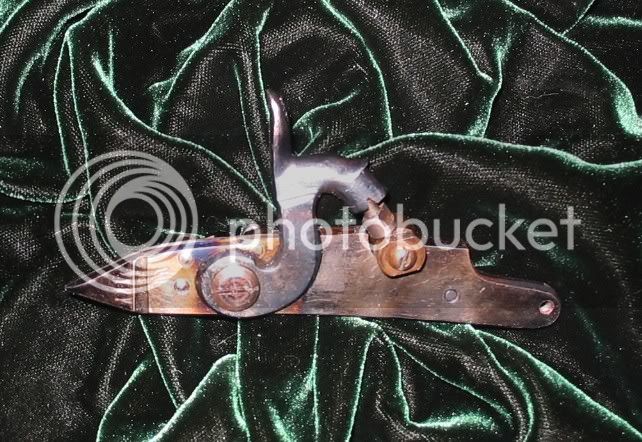
Heat coloring can NOT be done on a frizzen. The temperature is too high and it will remove much of the hardness frizzens need to provide a long life.
The rich dark blue color only happens in a rather narrow temperature range. Below that range the color will be purple and above that range the color will wash out to a gray.
By narrow range, a book I have says the temperature of mild steel at 540 degrees F is purple. At 570 degrees it will be blue and around 600 it will start to gray.
If a person has a high temperature furnace with precision heat controls it's easy. Without such a device maybe a pot of melted lead can do the job but to try to do it freehand with a propane torch usually makes a uneven pattern.
That can be used to ones advantage if they want to make a fake "color case hardened" look like I did on this lockplate.

Heat coloring can NOT be done on a frizzen. The temperature is too high and it will remove much of the hardness frizzens need to provide a long life.
Staggerwing
40 Cal.
Yep, trying to evenly heat something that size with a torch was my concern. May have to get creative and figure out a way to evenly heat the lock and hammer.
The video above looks easy....if you have the right equipment.
I just think the bluing created by heating to proper temperature would look really good on the lock.
The video above looks easy....if you have the right equipment.
I just think the bluing created by heating to proper temperature would look really good on the lock.
Personally, I prefer them nekkid and allow a natural patina to form with time and use. Your gun, yer call.
A lot of TC stocks, especially the older ones sure had some nice grain patterns.
The wood on early TCs was simply a matter of luck of the draw. When we bought my wifes Seneca she cherry picked what the dealer (actually a distributor with a large inventory) had on hand and she picked a nice looking stock. The rest were all very plain. At a recent gun show in my town one seller had a TC Patriot pistol with one of the most knock-out beautiful stocks I have ever seen. I looked it over carefully and am convinced it came from the factory that way and was not a rebuild. Naturally, he was asking about 2X the money it was really worth.
Similar threads
- Replies
- 5
- Views
- 275




